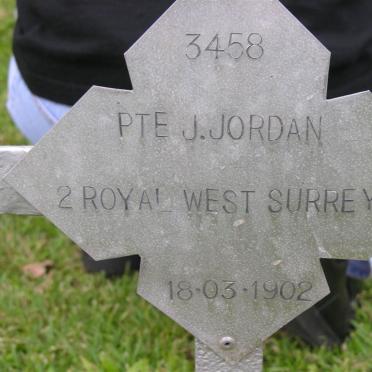Kwazulu-Natal, PINETOWN, Anglican Church, St. John, Cemetery
St John's Church, an Early History:-
Pinetown grew from a few scattered homesteads in the valley between what is now known as Kloof and Cowies Hill. Early church services were held in the "Parkhouse" in New Germany, with the Revd. Posselt of the Lutheran faith, the only ordained minister in the area, conducting services. Bishop Colenso, passing through Pinetown in 1854, was offered 5 acres of land by Mr Murray for the erection of a small church. Funds were raised, and on 3 December 1856, St John's, a little white-washed, thatched church was consecrated by the Right Reverend John William Colenso, first Bishop of Natal. Archdeacon Mackenzie was appointed to care for Pinetown and other coastal parishes with Reverend James Walton the permanent Vicar. This little church became the focal point of village life. During the latter half of the 19th Century, St John's was prominently involved in the dispute between the newly formed Church of the Province of South Africa under Bishop Grey of Cape Town and the supporters of Bishop Colenso's Church of England in South Africa. There were thus two churches in Pinetown claiming to be the Anglican Church, until the rift was healed in 1984 when Reverend William Bromilow became Vicar of St John's on 1 October. With the outbreak of the Zulu War in 1879, thousands of British troops were rushed to Natal to protect the area from invasion by the Zulus. Military camps were set up and Pinetown became an important garrison village. This changed the social and economic life of the village, besides increasing the Church congregation. Troops and family members who died, often through illness, were buried in St John's graveyard. After the war, many of the soldiers and their families stayed in the area. The 2nd Anglo-Boer War broke out in 1899 and because Natal was predominantly British, the young men of Durban and surrounding areas joined with the British forces. Troop trains regularly passed through Pinetown on their way to the northern battlefields. With an abundance of water close to the railway line and a healthy climate, Pinetown was the ideal spot for the military hospital. Mr Frank Stevens of Sarnia offered a portion of his land and the existing Fairydene buildings to the British Government for use as a military hospital. Mr Alfred Moseley of Middlesex donated equipment and a pre-fabricated hospital building which was shipped out from England in pieces. Helena, "Princess Christian", a daughter of Queen Victoria, gave her name to the 13th Stationary Hospital which was officially opened on 26 May 1900. Both troops and Boer Prisoners of War were treated at the hospital. Cases of enteric fever accounted for 26 deaths and there were a further 7 deaths from dysentery. A return of deaths at the hospital recorded 47 fatalities of which 3 were officers, 43 troops and Petrus Pretorius, a Prisoner of War. The deceased were buried at St John's Cemetery in Pinetown and the Marianhill Mission. The hospital closed in 1902. In 1905, the Fairydene Hotel was opened by Mr Frank Stevens on the site of the hospital, a Pinetown landmark. In 1985 it became the present Fairydene Retirement Home. The Guild of Loyal Women erected the sandstone Anglo-Boer War Memorial in the cemetery in 1922. Mr Steve Watt, an authority on military grave sites around the country has assisted with the refurbishing of the original crosses which will be re-erected in accordance to the military grave site plan. A new plaque made from granite is to be installed in the memorial. Rev. Fr. Basil G. Royston
Photographs by Basil Royston, Brain Kaighin and Eleanor Garvie
eGGSA captions Basil Royston, Eleanor Garvie & Dal Good.
Album incomplete, we do not have photographs of all the headstones. Information also available on the GGSA Cemetery DVD:- Cemetery ID: 808 Names in cemetery: 963 Google Earth Project Information:- GPSID: 808 GPS: Not available



























